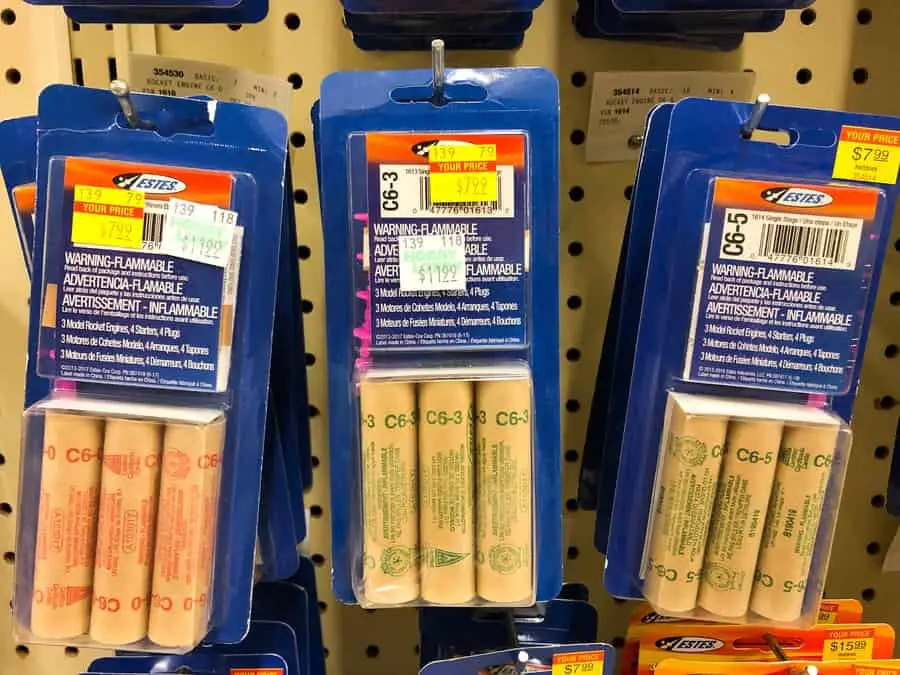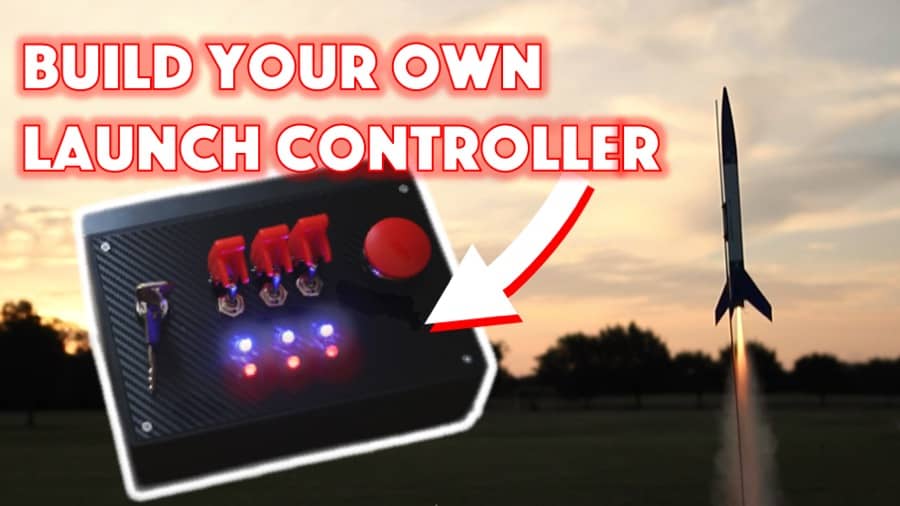
The more addicted to model rocketry that you become, the more you’re going to fly through those engines. What at first is not a large investment becomes more so as you increase the size and power of your engines. You will soon be wondering if there is a way to reuse an engine.
So, are model rocket engines reusable? Most small model rocket engines you would use in everyday model rocketry are not reusable, but many high powered model rocketry enthusiasts use a reloadable motor system which allows you to refill the engine’s casing with fuel.
In this article, I will explain why most model rocket engines are not reusable and give you everything you need to know about reloadable motors.
Are you still using the standard Estes controllers for your launches?
We just built our own beautiful launch controllers that make launches SO much more fun, and we documented EVERY single step and item purchased and put it into a step-by-step course that teaches you how to do the exact same thing.
Click here to learn more about how you can build your own launch controllers!

Black Powder Model Rocket Engines
In order to understand why you cannot reuse a typical model rocket engine, you must first understand how the engine works.
Most model rocket engines are solid propellant engines made out of black powder. If you were to cut open a model rocket engine, which you should never do, you would see that the tube is filled with compacted black, gray, and white material.
The clay nozzle is where you put the igniter and it is whitish, and after that comes the propellant. The propellant, in most cases black powder, is black and usually is the largest section of the motor.
This is followed by the delay which is generally a lighter gray. The delay slows down the rate at which the motor burns up before it reaches the ejection charge. The ejection charge is what activates your recovery system. It is all topped with a white clay cap.
After you use the engine, you may still be able to see the clay caps in both ends, but inside, the propellant, the delay, and the ejection are completely used up. If you would like to see a neat video of see through model rocket engine being ignited, check this out. It makes it all too clear why a black powder engine cannot be reused.
Now you may be wondering if you can refill the engine with black powder, which is essentially just gunpowder and pretty easy to get a hold of. The answer is quite simply no.
You cannot refill a black powder model rocket casing because in order to make a model rocket engine you need to stamp down the black powder and make it as compact as possible using rocket tooling.
This process is not safe in the least. Ramming black powder will heat it up. Too much heat, and your rocket could explode right in front of you.
Additionally, the motor casings themselves should not be reused if you decide to get into making your own model rocket engines as the casing has already undergone a lot of stress with its first launch.
The stress the engine had to endure would be intense and they could have become damaged. A visual inspection would not be enough to tell you if the casing could endure a second launch.
The result of reusing an old casing when making your own engines would be creating an unsafe engine with a high likelihood of a catastrophic failure.
Single Use Composite Engines
Single use composite engines are very similar to black powder engines. Composite engines are also solid propellant engines, but instead of black powder, they use a mixture of fuel and oxidizer that undergo a chemical reaction to create a composite material.
Instead of cardboard, single use composite engines usually have a plastic casing with a small nozzle in one end. Beyond that, they work in a very similar way to black powder engines.
Single use composite engines cannot be reloaded with fuel for the same reasons that a black powder motor casing cannot be reused. The casing is not structurally sound enough to be reused.
The Benefits of Composite Engines
Composite engines of all sizes are becoming increasingly popular since Aerotech began making them in the 1980s. There are several advantages that composite engines have over traditional black powder engines.
Composite engines are more reliable and therefore safer than black powder engines. The compacted black powder tends to be very brittle and cracks easily, which could cause an engine to fail. The composite material is more rubbery than black powder and does not crack as easily.
Additionally, a lot of power can be fit into a smaller package with composite engines. If you have two engines, one with an ounce of black powder and the other with an ounce of composite fuel, the composite fuel will have a higher total impulse and be more powerful.
Composite engines have extra customization options. You may notice that the codes for composite engines often have extra letters at the end. This extra letter typically indicates a feature of the engine’s launch. For example, the letter could indicate the smokiness or the color of the fire that comes out of the rocket. And who wouldn’t love to color coordinate their rocket and their engine’s fire?
Reloadable Composite Engines
Aerotech first came out with reloadable motor systems in 1990, and they have been a popular and cost effective alternative ever since.
A reloadable composite engine allows you to reuse the engine’s casing by refilling it using a propellant kit. In order to use a reloadable composite engine, you will need to get a casing. They usually come with the forward closure and the aft closure, but this is not always the case.
The initial investment you must make in the casing is high. The casings range is price from about $50 to up to $150 depending on the size and brand, but you end up saving money in the long run as long as you don’t lose the casing in a launch.
In addition to the casing, you will also need a propellant kit for each launch you want to make. The Aerotech propellant kit includes just about everything you might need to reload the engine including the composite propellant, the delay, o-rings, liners, nozzle, ejection charge, and starter.
You may need a few easy to come by items in order to reload the engine’s casing to the propellant kit like petroleum jelly, tape, paper towels, and an exacto knife.
An alternative to the Aerotech reloadable motor system is the Cesaroni reloadable motor system. These two systems are not interchangeable.
The Cesaroni propellant kits involve far less work on your part to reload the casing. The propellant comes almost completely ready to go. The only adjustment, you may need to make is to alter the time delay.
Some people prefer the Cesaroni for the ease of use, while others like to put the motors together on their own. The reload kits for Cesaroni do tend to be slightly more expensive but are much easier to put together. Which is better is really a matter of taste.
Buying a Casing for a Reloadable Engine
When purchasing your first reloadable case, you might be a little baffled by the coding system. It doesn’t look anything like the engine code listed on single use motors, and that is because it can’t, like single use motors, describe the total impulse, the average thrust, or the time delay that you decide to use.
Instead, the code on reloadable model rocket casings will tell you how much total impulse the casing can handle.
The code will look something like this: RMS-29/60.RMS stands for Reloadable Motor System and basically means that what you are looking at is the casing for a reloadable motor.
The first number, in this case a 29, is the lowest total impulse in Newton seconds that you would want to install in the motor. The second number, the 60, is the highest total impulse in Newton seconds you could install in this casing.
These numbers will help you purchase the correct propellant kit for your casing.
Why Use Reloadable Composite Engines?
Along with the benefits of using composite engines in general, there are a few reasons you might be interested in using a reloadable composite engine in the future.
Reloadable composite engines will save you money. The initial cost of the casing is high, but the propellant kits are much less than the cost of buying a single use composite engine. You typically save between $6 and $10 per launch by using reloadable kits (source).
Reloadable composite engines are fun! They give you the experience of building your own engine without the dangers of brewing your own rocket fuel. They are perfect for the do it yourselfers in the model rocket community, of which there are a great many.
Can Anyone Use a Reloadable Engine?
No. Not anyone can use a reloadable engine. There are rules concerning the purchase of the casing and the reload kits.
First of all, to purchase any engine that housed in a metal casing, regardless of the size of the motor, you must be 18 years old. All reloadable engines use metal casings.
Additionally, all of the reloadable kits require that you are 18 years of age or older to purchase them.
There are also certifications required to purchase model rocket engines of certain sizes, and many casings and propellant kits are meant for high powered engines.
If you’re looking to fly a high power model rocket, you’re going to need at least a Level 1 certification from the National Association of Rocketry. A high power model rocket engine is one that has an average impulse of 80 or greater. This includes some F and G motors and all H or higher motors.
This means if you wish to use a high powered reloadable engine, you will also need to get the appropriate certification first.
Hybrid Reloadable Engines
Hybrid model rocket engines combine a solid propellant with a liquid oxidizer, but these are much less commonly used than the other two motors.
There does seem to be a hybrid reloadable engine available, but it is difficult to locate and the information available is limited. If you’re interested in using hybrid model rocket engines, you may want to find a mentor who has firsthand experience using hybrid engines.
The general appeal of hybrid motors is that they offer an even cheaper alternative to composite engines. They do require that you learn how to properly reload them and install them first, however.
Many people don’t bother seeking out hybrid motors. This is because they are more difficult to find, and most people don’t feel the need to learn another engine system.
Build Your Own Launch Controller
Don’t forget! You can ditch the stock controllers and confidently build your own from scratch using our step-by-step instructions and exact materials list! We promise this will make your launch experience 10x better, and using our course License to Launch you can be 100% confident you’ll be able to finish this project and be super proud of what you’ve built! Here’s a sneak peek below.
